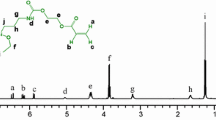Abstract
Controllable nanoporous structure in MTMS-based silicone aerogels is required to improve their thermal conductivity. Silicone aerogels were formed in a two-step acid–base catalysed sol–gel process combined with supercritical drying. The influence of MTMS concentration, specifically the molar ratio of methanol:MTMS and water:MTMS in the sol–gel process was studied in relation to the porous structure of resultant silicone aerogels. Samples were characterised to determine the dimensions of micro, meso and macro-pore structure by means of both nitrogen gas adsorption–desorption for detection of pores <300 nm and by analysis of FEG-SEM images for pores >300 nm. Porosity, pore volume distribution and Brunau er–Emmitt–Teller surface area in the silicone aerogels were all found to be influenced by adjustment of the molar ratio of methanol:MTMS and the molar ratio of water:MTMS during sol–gel processing.






















Similar content being viewed by others
References
Dorcheh AS, Abbasi MH (2008) Silica aerogel; synthesis, properties and characterization. J Mater Process Technol 199(1–3):10–26
Sarawade PB et al (2007) High specific surface area TEOS-based aerogels with large pore volume prepared at an ambient pressure. Appl Surf Sci 254(2):574–579
Bhagat SD, Rao AV (2006) Surface chemical modification of TEOS based silica aerogels synthesized by two step (acid–base) sol–gel process. Appl Surf Sci 252(12):4289–4297
Rao A et al (2006) Synthesis of flexible silica aerogels using methyltrimethoxysilane (MTMS) precursor. J Colloid Interface Sci 300(1):279–285
Rao AV et al (2003) Superhydrophobic silica aerogels based on methyltrimethoxysilane precursor. J Non-Cryst Solids 330(1–3):187–195
Rao VA, Hegde ND, Shewale PM (2007) Imperviousness of the hydrophobic silica aerogels against various solvents and acids. Appl Surf Sci 253(9):4137–4141
Hegde N, Rao A (2007) Physical properties of methyltrimethoxysilane based elastic silica aerogels prepared by the two-stage sol–gel process. J Mater Sci 42:6965–6971. doi:10.1007/s10853-006-1409-5
Sinko K (2010) Influence of chemical conditions on the nanoporous structure of silicate aerogel. Materials 2010(3):704–740
Uhlmann DR et al (1986) Kinetic processes in sol–gel processing. In: Hench LLU, Donald R (eds) Science of ceramic chemical processing. Wiley-Interscience, New York, pp 173–183
MacKenzie KJD (1986) Applications of the sol–gel method: some aspects of initial processing. In: Hench LLU, Donald R (eds) Science of ceramic chemical processing. Wiley, New York, pp 113–122
Pajonk GM (1989) Drying methods preserving the textural properties of gels. Rev Phys Appl 24:4–13
Chang SY, Ring TA (1992) Map of gel times for three phase region tetraethoxysislane, ethanol and water. J Non-Cryst Solids 147–148:56–61
Pajonk GM et al (1990) From sol–gel to aerogels and cryogels. J Non-Cryst Solids 121:66–67
Einarsrud MA et al (2001) Strengthening of silica gels and aerogels by washing and aging processes. J Non-Cryst Solids 285:1–7
Brinker CJ, Prakash SS (1999) Ambient pressure process for preparing aerogel thin films reliquified sols useful in preparing aerogel thin films. University of New Mexico, Albuquerque, p 12
Liu Y et al (2001) Development of porous silica thick films by a new base-catalyzed sol–gel route. Mater Lett 49(2):102–107
Liu Y et al (1999) New method for making porous SiO2 thin films. Thin Solid Films 353(1–2):124–128
Sing KSW et al (1985) Reporting physisorption data for gas/solid system with special reference to the determination of surface area and porosity. Pure Appl Chem 57:603–619
Al-Oweini R, El-Rassy H (2010) Surface characterization by nitrogen adsorption of silica aerogels synthesized from various Si(OR)4 and R″Si(OR′)3 precursors. Appl Surf Sci 257(1):276–281
Barrett EP, Joyner LG, Halenda PP (1951) The determination of pore volume and area distributions in porous substances I computations from nitrogen isotherms. J Am Ceram Soc 73:373–380
Zhang ZM (2007) Nano/microscale heat transfer. McGraw-Hill Companies, New York, p 479
Vignoles GL (1995) Modelling binary, Knudsen and transition regime diffusion inside complex porous media. Colloq Suppl J Phys II(5):159–166
Gruener S, Huber P (2008) Knudsen diffusion in silicon nanochannels. Phys Rev Lett 100:1–4
Xu B et al (2012) An improved method for preparing monolithic aerogels based on methyltrimethoxysilane at ambient pressure Part I: process development and macrostructures of the aerogels. Microporous and Mesoporous Mater 148(1):145–151
Gurav J, Nadargi D, Rao A (2008) Effect of mixed catalysts system on TEOS-based silica aerogels dried at ambient pressure. Appl Surf Sci 255:3019–3027
Nadargi DY, Rao AV (2009) Methyltriethoxysilane: new precursor for synthesizing silica aerogels. J Alloy Compd 467(1–2):397–404
Amaral-Labat G et al (2012) Impact of depressurizing rate on the porosity of aerogels. Microporous and Mesoporous Mater 152:240–245
Bogush GH, Tracy MA, Zukoski CF (1988) Preparation of monodisperse silica particles: control of size and mass fraction. J Non-Cryst Solids 104:95–106
Rahman IA et al (2007) An optimized sol–gel synthesis of stable primary equivalent silica particles. Colloids Surf A 294(294):102–110
Acknowledgements
We would like to thank the financial support of Overseas Research Studentship (UK) and the University of Leeds Research Studentship for the research project.
Author information
Authors and Affiliations
Corresponding author
Rights and permissions
About this article
Cite this article
Du, M., Mao, N. & Russell, S. Control of porous structure in flexible silicone aerogels produced from methyltrimethoxysilane (MTMS): the effect of precursor concentration in sol–gel solutions. J Mater Sci 51, 719–731 (2016). https://doi.org/10.1007/s10853-015-9378-1
Received:
Accepted:
Published:
Issue Date:
DOI: https://doi.org/10.1007/s10853-015-9378-1




